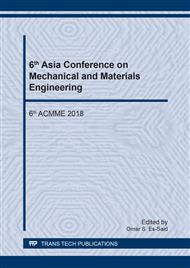[1]
N.K. Srivastava and C.B. Majumder: Novel biofiltration methods for the treatment of heavy metals from industrial wastewater., J. Hazard. Mater. 151, 1-8, (2008).
Google Scholar
[2]
Manzoor, Q., Nadeem, R., Iqbal, M., Saeed, R., Ansari, T.M.: Organic acids pretreatment effect on Rosa bourbonia phyto-biomass for removal of Pb(II) and Cu (II) from aqueous media, Bioresour. Technol. 132, 446–452, (2013).
DOI: 10.1016/j.biortech.2013.01.156
Google Scholar
[3]
National Center for Biotechnology Information. PubChem Compound Database; CID=5352425, https://pubchem.ncbi.nlm.nih.gov/compound/5352425 (accessed Feb. 8, 2018).
Google Scholar
[4]
Rashmi Verma and Pratima Dwivedi: Heavy metal water pollution - A case study, Recent Research in Science and Technology, 5(5), 98-99, (2013).
Google Scholar
[5]
Fenglian Fu and Qi Wang: Removal of heavy metal ions from wastewaters: A review, Journal of Environmental Management 92, 407-418, (2011).
DOI: 10.1016/j.jenvman.2010.11.011
Google Scholar
[6]
R. Naseem and S. S. Tahir: Removal Of Pb(II) From Aqueous/Acidic Solutions by Using Bentonite As an Adsorbent, Water Res. 35, 3982-3986, (2001).
DOI: 10.1016/s0043-1354(01)00130-0
Google Scholar
[7]
Ashutosh Tripathi and Manju Rawat Ranjan: Heavy Metal Removal from Wastewater Using Low Cost Adsorbents, Journal of Bioremediation & Biodegradation, 6:6, (2015).
DOI: 10.4172/2155-6199.1000315
Google Scholar
[8]
Jusoha, A., Lam, S.S., Noraaini, A., Noor, M.J.M.M.: A simulation study of the removal efficiency of granular activated carbon on cadmium and lead, Desalination 206, 9–16, (2007).
DOI: 10.1016/j.desal.2006.04.048
Google Scholar
[9]
Gaballah I, Goy D, Allain E, Kilbertus G, Thauront J.: Recovery of copper through decontamination of synthetic solutions using modified barks, Met Metall Trans.B 28: 13-23, (1997).
DOI: 10.1007/s11663-997-0122-3
Google Scholar
[10]
Nakajima A and Sakaguchi T: Recovery and removal of uranium by using plant wastes, Biomass 21: 55-63, (1990).
DOI: 10.1016/0144-4565(90)90047-n
Google Scholar
[11]
Jain, K.C., Malik, D.S., Yadav, A.K.: Applicability of plant based biosorbents in the removal of heavy metals: a review. Environ. Process. 3, 495–523 (2016).
DOI: 10.1007/s40710-016-0143-5
Google Scholar
[12]
de Melo, D.Q., de Sousa Neto, V.O., de Barros, F.C.F., Raulino, G.S.C., Vidal, C.B., Nascimento, R.F.: Chemical modifications of lignocellulosic materials and their application for removal cations and anions from aqueous solutions. J. Appl. Polym. Sci. 43, 43286 (2016).
DOI: 10.1002/app.43286
Google Scholar
[13]
Wang, J., Le, J., Wei, J.: Adsorption characteristics of noble metal ions onto modified straw bearing amine and thiol groups. J. Mater. Chem. A 3, 18163–18170 (2015).
DOI: 10.1039/c5ta05371d
Google Scholar
[14]
Jeon, C. and Kim, J.H.: Removal of lead ions using phosphorylated sawdust, Journal of Industrial and Engineering Chemistry 15: 910–913, (2009).
DOI: 10.1016/j.jiec.2009.09.023
Google Scholar
[15]
Masato Igura and Masanori Okazaki: Cadmium sorption characteristics of phosphorylated sago starch-extraction residue, Journal of Hazardous Materials, Volume 178, Issues 1–3, Pages 686-692, (2010).
DOI: 10.1016/j.jhazmat.2010.01.142
Google Scholar
[16]
Jeon, C., Cha, J.H., Choi, J.Y.: Adsorption and recovery characteristics of phosphorylated sawdust bead for indium(III) in industrial wastewater, Journal of Industrial and Engineering Chemistry Volume 27, Pages 201-206, (2015).
DOI: 10.1016/j.jiec.2014.12.036
Google Scholar
[17]
Pari and Roliadi: Alternative technology for the utilization of biomass waste from wood industries, Proceeding of the international workshop on better utilization of forest biomass for local community and environments, Research and Development Center for Forest Products Technology, (2004).
Google Scholar
[18]
Qin Li, Jianping Zhai, Wenyi Zhang, Mingmei Wang, Jun Zhou: kinetic studies of adsorption of Pb(II), Cr(III) and Cu(II) from aqueous solution by sawdust and modified peanut husk, Journal of Hazardous Materials 141, 163–167, (2007).
DOI: 10.1016/j.jhazmat.2006.06.109
Google Scholar
[19]
Ningchuan Feng and Fengyuan Zhang: Untreated Chinese ephedra residue as biosorbents for the removal of Pb2+ ions from aqueous solutions, Proceeding Enviromental Science, 18, 794-799, (2013).
DOI: 10.1016/j.proenv.2013.04.107
Google Scholar
[20]
Naiya, T.K., Chowdhury, P., Bhattacharya, A.K., Das, S.K.: Saw dust and neem bark as low-cost natural biosorbent for adsorptive removal of Zn(II) and Cd(II) ions from aqueous solutions, Chemical Engineering Journal 148, 68–79 (2009).
DOI: 10.1016/j.cej.2008.08.002
Google Scholar


